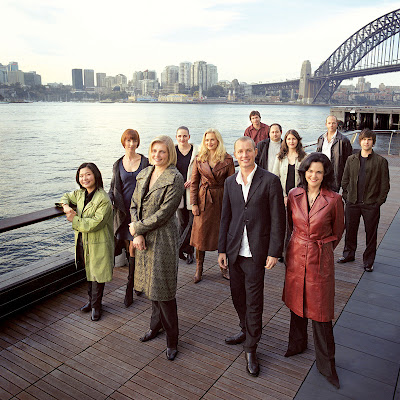Australian Chamber Orchestra, Pieter Wispelwey
 Australian Chamber Orchestra, photo by Stephen Oxenbury |
| Australian Chamber Orchestra: Bach, Keyboard Concerti 1, A. Hewitt Bach, Keyboard Concerti 2, A. Hewitt Vivaldi, Flute Concerti, E. Pahud Pieter Wispelwey: Bach Suites Beethoven Sonatas/Variations, D. Lazic Haydn Concerti |
The first half concluded with a Viennese classical concerto, Haydn's C major cello concerto (Hob. VIIb), for which the ACO was joined by Pieter Wispelwey. The Dutch cellist, at home on period and modern instruments, set the tone for the piece with a full-throated sound that lent a certain rustic, jolly quality. Wispelwey's extended cadenzas, similar to what he played on his recording of the Haydn cello concerti, were eclectic and fun, if not particularly idiomatic to the period. Replete with challenging pizzicati, strummed chords, and multiple stops, the cadenzas played against the earthy simplicity established in the first movement. An expansive, stately slow movement and a white-knuckled "very fast" Allegro molto, showing off the facility and accuracy of the entire group, rounded out a fine rendition of this popular concerto, rediscovered only in the mid-20th century. One hoped for a movement from a Bach suite -- on the basis of Jens's review of Wispelwey's recording -- as an encore, as he had played in previous appearances on this tour. No one was disappointed when, quietly observing the passing of Mstislav Rostropovich earlier in the day, Wispelwey offered instead a movement from Benjamin Britten's suite for unaccompanied cello (the passacaglia from the third suite, I think), composed for and dedicated to Rostropovich. As the final notes trailed off into the air, sotto voce and morendosi, it made me imagine Slava circling the earth to listen to the many tributes offered in his memory that night.
Daniel Ginsberg, Aussies Have Lots of Style, And Even More Substance (Washington Post, April 30) David Perkins, Australian orchestra outshines its guest (Boston Globe, April 24) Richard S. Ginell, Dry Baroque pieces from Down Under (Los Angeles Times, April 18) Laura Stewart, Chamber group from Down Under is tops (Daytona Beach News-Journal, April 18) |
The Australian Chamber Orchestra plays the same program this evening at Zankel Hall in Manhattan (April 29, 7:30 pm).





















































1 comment:
In case you are interested, there is an amazing video of the Eroica symphony played by the ACO in February of this year, available in full for free:
http://www.aco.com.au/Index.aspx?EID=295
Post a Comment